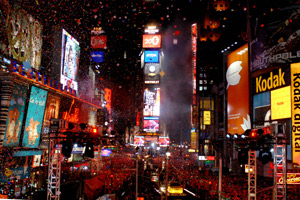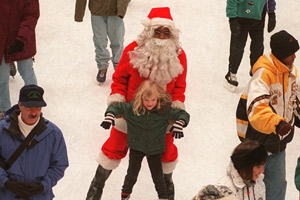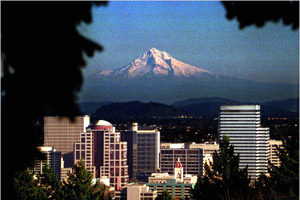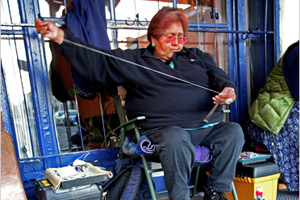Focus on America
New York City gets ready for its annual New Year Celebration

For much of the past century, Americans have associated the new year with festivities in New York City’s Times Square -- in the center of the nation’s largest, most diverse and perhaps most forward-looking city.
The millions who watch on television will see a crowd of happy celebrants hundreds of thousands strong. The New Yorkers there will be drawn from a city whose boundless energy, ambition and drive constantly is replenished by immigrants from across the globe. These revelers and their "city that never sleeps" represent the triumph of individual grit, determination, perseverance and -- particularly appropriate as the new year approaches -- the chance to make a new start. (See related article.)
From its earliest days as a Dutch settlement, New Amsterdam, on the southern tip of Manhattan Island, the community that grew into today’s New York City, was relatively open and cosmopolitan. In the 1640s, when the population of New Amsterdam barely numbered 1,000, there already were some 15 languages spoken. Among these first New Yorkers were arrivals from Germany, Switzerland, Moravia, France, Portugal, Great Britain and the Netherlands. Religious qualifications, then prevalent in much of Europe, did not prove an obstacle in what would become New York. In 1655, the Dutch West India Company rejected as "unreasonable and unfair" Governor Peter Stuyvesants request to bar from the colony a group of Jews expelled from Portuguese Brazil.
Cosmopolitan openness flowed naturally in a city that prized commerce over social class. Just as today, opportunity drew immigrants who, eager to thrive and often denied similar opportunity elsewhere, were willing to work hard, take risks and innovate. Their success helped the city grow and thrive, and it inspired others -- often from very different parts of the world -- also to seek their fortunes in New York.
In 1860, nearly half the city’s population was foreign born. Irish-born Americans were the largest immigrant group during this era, followed by German-born Americans. During the years 1880–1919, some 23 million Europeans, many from southern and eastern Europe, immigrated to the United States. At least 17 million arrived in the United States through New York (after 1892 through the famous immigration center at Ellis Island) and enough stayed to afford the city a Russian, Polish, Italian and Jewish flavor. The term "melting pot" dates to this era, and refers to neighborhoods like Manhattan’s Lower East Side and East Village, where many among this wave of immigrants settled.
More recent arrivals have enriched New York’s ethnic and racial diversity to the point where today’s New Yorkers can trace their roots to more than 180 nations. The "Great Migration" of African Americans northward after 1910 brought many to New York, while immigrants from Asia and Latin America continue to drive the city’s growth. As of the 2000 census, nearly 36 percent of New Yorkers were foreign born, and a solid majority either were immigrants or the children of immigrants. The leading countries of origin for foreign-born New Yorkers were the Dominican Republic, China, Jamaica, Guyana, Mexico and Ecuador, according to the census.
In 2000, the citys total population topped 8 million, of which nearly 30 percent claimed Hispanic heritage, more than 26 percent were African American and almost 10 percent Asian. Nearly one-third of the city’s black population is now of Caribbean origin. While the largest ethnicities in today’s New York -- Puerto Rican (9.8 percent), Italian (8.7 percent) and Irish (5.3 percent) -- represent earlier immigration flows, Dominicans (5.1 percent) and Chinese (4.5 percent) are now also among the most populous groups.
CULTURAL DIVERSITY AND COMMERCE
Many of the citys 800 neighborhoods retain definite ethnic flavoring. Little Italy and Chinatown, both tourist favorites today, first emerged during the 19th century; Harlem became a vibrant center of African-American life after 1910. Other groups have established similar enclaves:
• Dominicans in Washington Heights (in Manhattan) and the west Bronx;
• Chinese in Manhattans Chinatown neighborhood and in Flushing, Queens;
• Jamaicans in the central Brooklyn neighborhoods of Flatbush, East Flatbush and Crown Heights; and
• Guyanese of Asian descent in Richmond Hill, Queens, and Guyanese of African descent in Flatbush, a neighborhood also home to many Haitian New Yorkers.
Immigrants from India, Russia, Ecuador, Mexico and Columbia are a vital presence in several Brooklyn and Queens neighborhoods.
The Number 7 subway line to heavily Chinese and Korean Flushing by way of several ethnic neighborhoods is possibly the most diverse spot in the United States. One hears on the train many of the more than 120 languages spoken in the New York City public schools.
New York remains very much a commerce-centered city, although the nature of that commerce has changed. Originally a shipping and manufacturing center, New York increasingly relies on its financial industry and such creative fields as journalism, advertising and publishing. Its "Fashion Avenue" and "Diamond District" remain centers of their respective industries.
New York also is a major American cultural center, home to a host of leading museums, performing arts arenas and art galleries. Its Broadway theaters, many of which are only a few steps from Times Square, constitute the heart of American professional theater.
Over time, immigrant groups gradually have assumed more prominent roles in every aspect of city life. The last three mayors have been an African American, an Italian American and a Jewish American. The powerful union leader who recently sparked a transit workers strike is a Haitian American.
In the theater world, to look to just one area of artistic endeavor, Jewish songwriters were integral to the development of the Broadway musical, while black playwrights began making their mark on Broadway during the 1970s and recent years have seen the arrival in force of Hispanic-penned shows.
As one might expect in a city that attracts and rewards the talented and ambitious, New Yorkers often can seem rushed and a bit intolerant, traits that reflect their impatience and eagerness always to move forward. The idiom "in a New York minute" means "immediately" and reflects that impatience.
New York always has been among the most future-oriented and forward-looking of cities, and thus a fine place for its mosaic of peoples to ring in the New Year. As the author and critic Brendan Gill has said: "You feel, in New York City, the energy coming up out of the sidewalks, you know that you are in the midst of something tremendous, and if something tremendous hasn yet happened, its just about to happen."
Recently on Focus on America
Christmas, celebrated by most Christians on December 25.
 Christmas, celebrated by most Christians on December 25, commemorates the birth of Jesus of Nazareth. Americans, like many of the world’s peoples, have developed their own Christmas traditions and observances, and these have changed greatly over time.
Christmas, celebrated by most Christians on December 25, commemorates the birth of Jesus of Nazareth. Americans, like many of the world’s peoples, have developed their own Christmas traditions and observances, and these have changed greatly over time.
Wealth and Hard Times Mingle in Northwest Oregon
 The Oregon 1st Congressional District stretches from a vibrant metropolitan area, across densely packed suburbs and rolling farm country through the mists of forested hills before ending on one of the world’s most spectacular coastlines.
The Oregon 1st Congressional District stretches from a vibrant metropolitan area, across densely packed suburbs and rolling farm country through the mists of forested hills before ending on one of the world’s most spectacular coastlines.
History, Culture and Science Shape Central New Mexico
 New Mexico’s 1st Congressional District is a swing district in a swing state. Situated in the geographic center of this southwest border state, the district climbs from desserts to mountains.
New Mexico’s 1st Congressional District is a swing district in a swing state. Situated in the geographic center of this southwest border state, the district climbs from desserts to mountains.